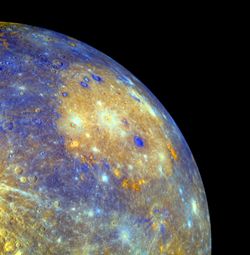Mercury
Mercury
The closest planet to the Sun, Mercury orbits in only 88 Earth days.
However, its rotation is so slow that a "day" on Mercury lasts twice as long
as its year.

Credit: (NASA/JHU APL/ASU/CIW)
Smallest of the inner terrestrial planets, Mercury has been
geologically inactive for billions of years and its surface is peppered with
craters of all sizes, including the Caloris Basin, one of the largest impact
sites in the solar system. The surface temperatures range from -170 °C
(-275 °F) on the night side to 450 °C (840 °F) on the day side.

Compositional variation in Caloris Basin
Credit: (NASA/JHU APL/ASU/CIW)
Fun Facts
- The Sun can look 10 times larger from Mercury than it does from Earth
- Mercury is the only other rocky planet besides the Earth with a global magnetic
field
- Mercury has the largest iron core relative to its size of any planet
Missions
Mariner 10: Flybys (1974 (2), 1975)
MESSENGER: Orbiter (2011 - )
